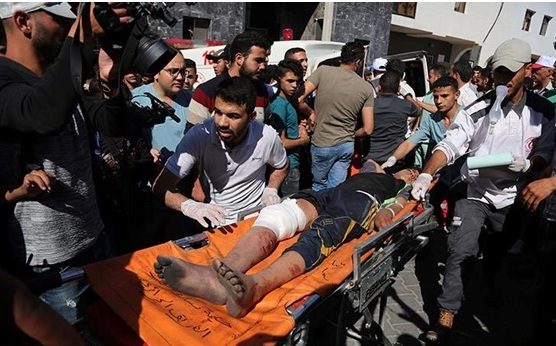Israel’s Supreme Court rejected on Thursday night, May 23, two petitions filed by human rights groups and, in doing so, fully asserted the “legality” of the Israeli military’s position, giving it a green light to continue using snipers and live fire against Palestinian protesters in the Gaza Strip.
Three Supreme Court justices unanimously rejected the two petitions – one filed by Adalah – The Legal Center for Arab Minority Rights in Israel and Al-Mezan Center for Human Rights – and the other submitted by the Association for Civil Rights in Israel (ACRI), Yesh Din, Gisha – Legal Center for Freedom of Movement, and HaMoked: Center for the Defense of the Individual – fully accepting the military’s claims related to the use of live fire against protesters.
The court ruled that the Israeli military’s firing of live ammunition at protesters was in accordance with the law because, according to the court, the protest participants constituted a real danger to Israeli soldiers and citizens.
Adalah and Al-Mezan responded late Thursday night to the Israeli Supreme Court’s ruling: “The Israeli Supreme Court completely ignored the broad factual basis presented to it by the petitioners, which includes multiple testimonies of wounded and reports of international organizations involved in documenting the killing and wounding of unarmed protesters in Gaza. It is worth noting that the Israeli Supreme Court refused to watch video clips documenting Israeli shootings of demonstrators and, rather than actually examining the case, fully accepted the claims presented to it by the state. The extreme nature of the ruling is also highlighted by the striking absence of any mention of the casualty figures that had been presented to the court.”
Adalah and Al-Mezan also noted, “This ruling, which justifies the shooting of protesters, contradicts the conclusions and preliminary results of international human rights organizations and United Nations bodies documenting and evaluating the events in Gaza. The Supreme Court’s ruling gives full legitimacy to the illegal actions of the Israeli military, which has led to the killing of more than 100 people and the wounding of thousands of protesters, including women, children, journalists, and paramedics. Of those killed, 94 percent were shot by Israeli troops in the upper body.”
Adalah and Al-Mezan filed their petition with the Israeli Supreme Court on April 23, demanding that it orders the Israeli military to stop using snipers and live ammunition in order to disperse Palestinian protests in the Gaza Strip.
Adalah Attorney Suhad Bishara argued in the petition that the Israeli military practices constitute violations of both international law as well as Israeli law:
The Israeli military’s “open-fire policy against protesters in Gaza is patently illegal… This policy perceives the Palestinian human body as an expendable, worthless object.”
Since March 30, 120 Palestinian residents of Gaza – including 14 children – have been killed by the Israeli military. At least 86 were killed during the protests themselves, including 12 children, two journalists, and three people with disabilities. Approximately 3,000 more were wounded by live fire during this same period. Those who were killed were mostly shot in the upper part of the body.
On May 17, Adalah and Al-Mezan released a briefing paper that takes an in-depth look at the petition challenging the Israeli military’s use of lethal force against Gaza protesters, as well as the State of Israel’s response, and the petitioners’ critique and arguments against the State’s positions.
The two organizations stressed in the petition that, contrary to the claims of the Israeli military and government, the Gaza protesters are unarmed demonstrators who never reached the point – at any stage – of imminently endangering anyone’s life during demonstrations to the extent that the use of lethal force would be necessary. The protest march’s general principles document, which was included in the petition, makes clear that the protests are popular, non-violent, and unarmed.
The petition emphasizes the absolute ban on opening fire on demonstrators with live ammunition and noted that the norms applicable to confronting civilian demonstrations are based in international law governing “law enforcement and order.” These same norms have also been adopted into Israeli law, including via the Or Commission Report published in 2003.
“These universal norms apply equally and without discrimination to citizens and non-citizens alike, regardless of the content of the protest, their slogans, their location, their organizational affiliation, and the ethnic and national affiliation of the participants.”
Nevertheless, the petition stresses, the Israeli military employed social media channels in advance of the protests to explicitly threaten Gaza residents that it would “fire live ammunition with a premeditated intent to kill or wound participants in an effort to deter future political protest.” The petition included 12 video clips documenting Israeli soldiers shooting unarmed protesters – including women and children – who posed no danger to anyone.



